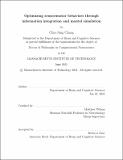Optimizing sensorimotor behaviors through information integration and mental simulation
Author(s)
Chang, Chia-Jung
DownloadThesis PDF (29.02Mb)
Advisor
Wilson, Matthew
Terms of use
Metadata
Show full item recordAbstract
To generate dynamic thoughts, make proper decisions and act appropriately, humans and animals need to make reliable estimates of the state of the world. Recent studies have shown that the brain reduces uncertainty associated with noisy measurements by strategies including incorporating prior knowledge with sensory cues, extracting lowdimensional manifolds from heterogeneous activities, and updating internal models through simulating upcoming events. However, it remains unclear whether the brain utilizes additional sources that might have been ignored in previous work. To address this question, my thesis starts by asking how implicit temporal rhythms are used during mental simulation of object trajectory with partial observations. By designing psychophysics experiments with varying spatial and temporal structures, I show that humans simulate temporal rhythms in addition to the kinematics when interacting with dynamic stimuli. Bayesian modeling further suggests that explicit kinematics and implicit timing are integrated optimally. Following this work, the neural mechanism of time reproduction is revealed by analyzing the dynamics of low-dimensional state-space from large-scale electrophysiology recordings. This approach is further applied to uncover mechanisms underlying fear observational learning, which would not be possible with a traditional single-cell analysis. In the next chapter, the idea of neural coding in calcium imaging studies is challenged by demonstrating that the background residuals represent additional behavioral information. By building a convolutional neural network, position and speed of the animals can be directly decoded from raw microendoscopic data. Critically, saliency maps of the model reveal emergence of video-decomposition, and identify neural clusters representing distinct behavioral aspects on original images. Finally, inspired by replays in the hippocampus, I design a reinforcement learning agent with mental simulation to approximate the relaxation of constrained optimization. The results reveal scenarios where simulating to break physical barriers can improve learning efficiency. Together, my thesis examines how additional information may be integrated with spatial and temporal simulation to optimize complex sensorimotor behaviors, and proposes efficient models for decoding and learning.
Date issued
2021-06Department
Massachusetts Institute of Technology. Department of Brain and Cognitive SciencesPublisher
Massachusetts Institute of Technology